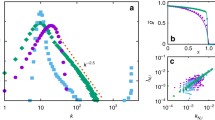Abstract
Beginning from the notion of semantic network structure, we develop a quantitative description of how much can be learned by an animal whose developmental programme is a set of co-acting epigenetic rules. In the model considered, the activity of the rules regulates the size, connectivity and innate information content of the semantic network. The network itself is associated with a behavioral repertoire. The modeling approach shows how to begin accounting for the effects of both genetic and environmental information, in a manner that quantifies the roles of specific epigenetic rules for psychological development. In previous models the Shannon-Weaver information contentI of a semantic network follows power lawsI ∞N ξ, withN the number of interrelated concept elements in the network and ξ a scaling exponent labeling a universality class of semantic networks. Our calculations provide evidence that epigenetic rules of the type considered, involving both innate and learned semantic network components, sustain a new universality class for which ξ=1.
Similar content being viewed by others
Literature
Anderson, J. R. and G. H. Bower. 1973.Human Associative Memory. New York: John Wiley.
Berwick, R. C. 1983. “Locality Principles and the Acquisition of Syntactic Knowledge.” Ph.D. thesis, department of Electrical Engineering and Computer Science, MIT.
Brainerd, C. J. (Ed.) 1983.Recent Advances in Cognitive-Developmental Theory. New York, Springer-Verlag.
Bremermann, H. J. 1963. “Limits of genetic control.”IEEE Trans. Milit. Electron. MIL7, 200–205.
Brillouin, L. 1962.Science and Information Theory. New York: Academic Press.
Chomsky, N. 1980.Rules and Representations. New York: Columbia University Press.
Collins, A. M. and E. F. Loftus. 1975. “A Spreading-activation Theory of Semantic Processing.”Psychol. Rev. 82, 407–428.
Conrad, C. 1972. “Cognitive Economy in Semantic Memory.”J. exp. Psychol. 92, 149–154.
Estes, W. K. 1982.Models of Learning, Memory, and Choice: Selected Papers. New York: Praeger.
Firestone, M. P., R. de Levie and S. K. Rangarajan. “On One-dimensional Nucleation and Growth of ‘Living’ Polymers. I. Homogeneous Nucleation.”J. theor. Biol. 104, 535–552.
Keil, F. C. 1981. “Constraints on Knowledge and Cognitive Development.”Psychol. Rev. 88, 197–227.
Lindsay, P. H. and D. A. Norman. 1977.Human Information Processing: An Introduction to Psychology, 2nd edn. New York: Academic Press.
Lumsden, C. J. 1983. “Gene-culture linkages and the developing mind.” InRecent Advances in Cognitive-developmental Theory, C. J. Brainerd (Ed.), pp. 123–166. New York: Springer-Verlag.
— and E. O. Wilson. 1981.Genes, Mind and Culture: The Coevolutionary Process. Cambridge, Massachusetts: Harvard University Press.
— and —. 1983.Promethean Fire: Reflections on the Origin of Mind. Cambridge, Massachusetts: Harvard University Press.
Majid, I., N. Jan, A. Coniglio and H. E. Stanley. 1984. “Kinetic Growth Walk: A New Model for Linear Polymers.”Phys. Rev. Lett. 52, 1257–1260.
Mayoh, B. H. 1974. “Multidimensional Lindenmeyer Systems.” InL Systems. Lecture Notes in Computer Science, G. Rozenberg and A. Saloma (Eds), pp. 302–326. New York: Springer-Verlag.
Meakin, P. and H. E. Stanley. 1983. “Spectral Dimension for the Diffusion-limited Aggregation Model of Colloid Growth.”Phys. Rev. Lett. 51, 157–1460.
Medin, D. L. and E. E. Smith. 1984. “Concepts and Concept Formation.”A. Rev. Psychol. 35, 113–138.
Nagl, M. 1976. “Graph Rewriting Systems and their Application in Biology.” InMathematical Models in Medicine.Lecture Notes in Biomathematics, J. Bergeret al. (Eds), Vol. 11, pp. 135–156. New York: Springer-Verlag.
Odian, G. 1981.Principles of Polymerization. New York: John Wiley.
Quillian, M. R. 1969. “The Teachable Language Comprehender: A Simulation Program and Theory of Language.”Communs Ass. comput. Mach. 12, 459–476.
Rangarajan, S. K. and R. de Levie. 1983. “On One-dimensional Nucleation and Growth of ‘Living’ Polymers. II. Growth at Constant Monomer Concentration.”J. theor. Biol. 104, 553–570.
Savitch, W. J. 1976. “Computational Complexity of Developmental Programs.” InAutomata, Languages, and Development, A. Lindenmeyer and G. Rosenberg (Eds), pp. 283–291. Amsterdam: North Holland.
Schaeffer, B. and R. Wallace. 1969. “Semantic Similarity and the Comparison of Word Meanings.”J. exp. Psychol. 82, 343–346.
— and —. 1970. “The Comparison of World Meanings.”J. exp. Psychol. 86, 144–152.
Shepher, J. 1971. “Mate Selection among Second-generation Kibbutz Adolescents and Adults: Incest Avoidance and Negative Imprinting.”Archs sexual Behav.1, 293–307.
Sowa, J. F. 1984.Conceptual Structures. Reading, Massachusetts: Addison-Wesley.
Tulving, E. 1972. “Episodic and Semantic Memory.” InOrganization of Memory, E. Tulving and W. Donaldson (Eds). New York: Academic Press.
Volkenstein, M. V. 1963.Configuration Statistics of Polymeric Chains. New York: John Wiley.
Wexler, K. and P. K. Culicover. 1980.Formal Principles of Language Acquisition. Cambridge, Massachusetts: MIT Press.
Wickelgren, W. A. 1979.Cognitive Psychology. Englewood Cliffs, New Jersey: Prentice-Hall.
Wilkins, A. J. 1971. “Conjoint Frequency, Category Size, and Categorization Time.”J. verb. Learn. verb. Behav. 10, 382–385.
Wilson, K. V. N. 1980.From Associations to Structure: The Course of Cognition. New York: North Holland.
Author information
Authors and Affiliations
Rights and permissions
About this article
Cite this article
Masui, S., Lumsden, C.J. A mathematical approach to semantic network development. Bltn Mathcal Biology 47, 629–650 (1985). https://doi.org/10.1007/BF02460130
Received:
Revised:
Issue Date:
DOI: https://doi.org/10.1007/BF02460130




